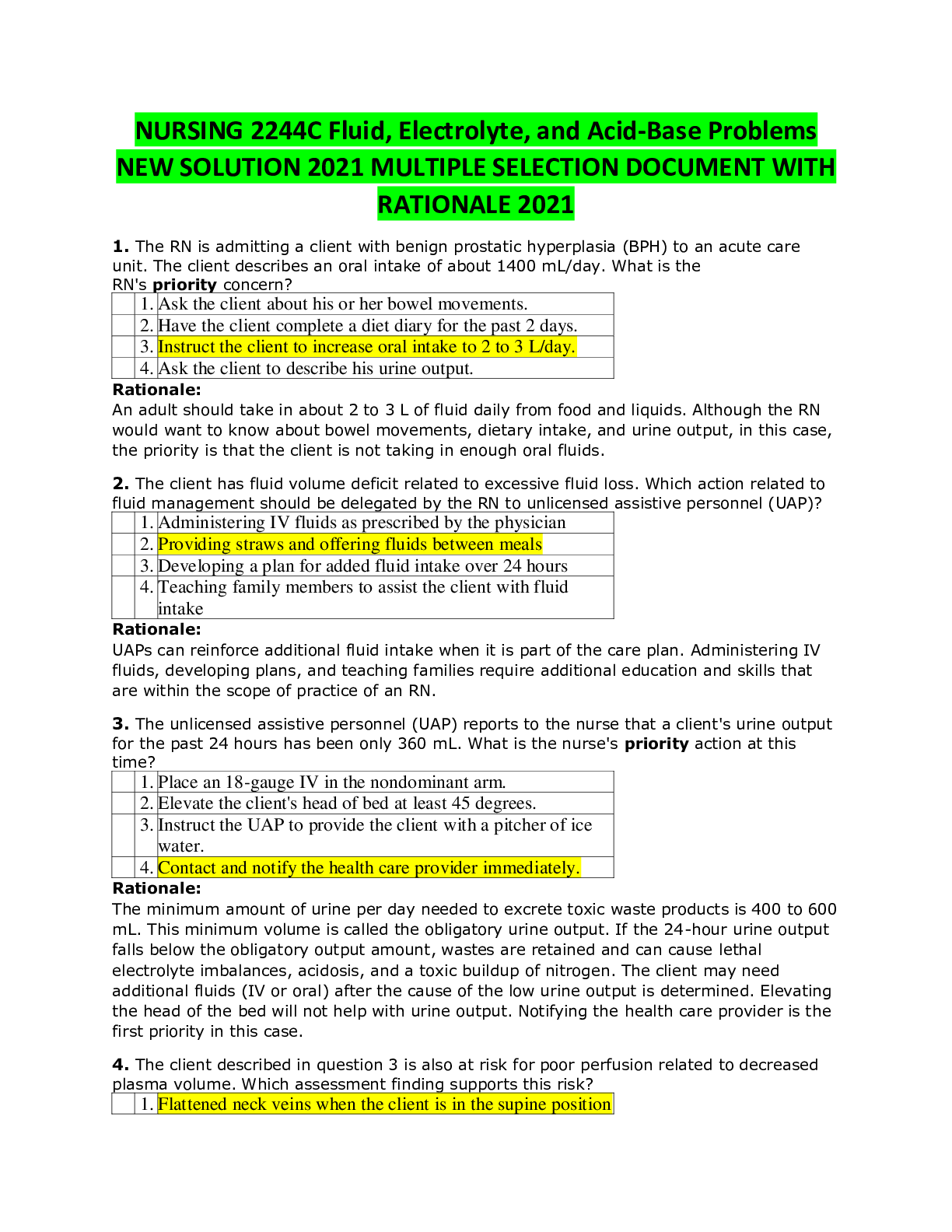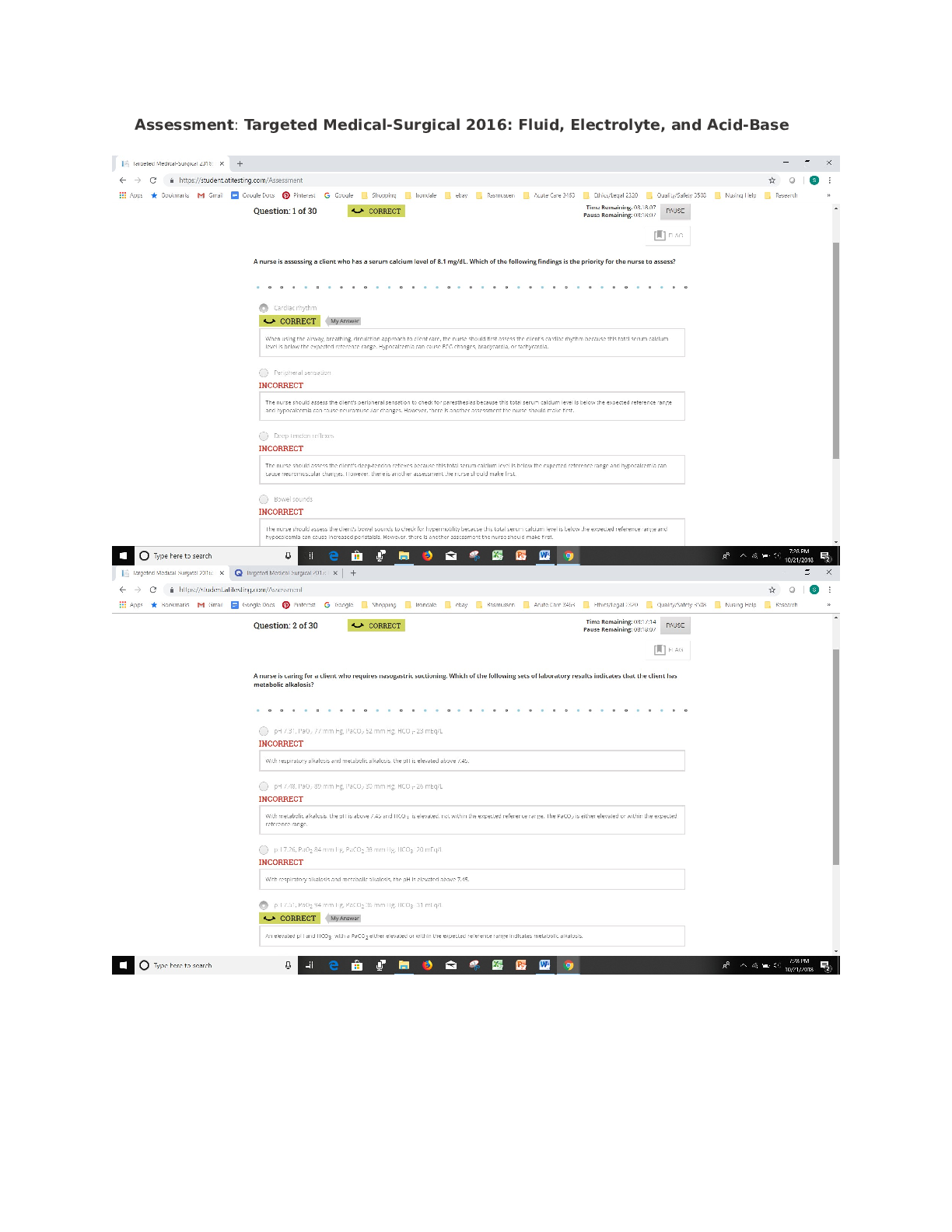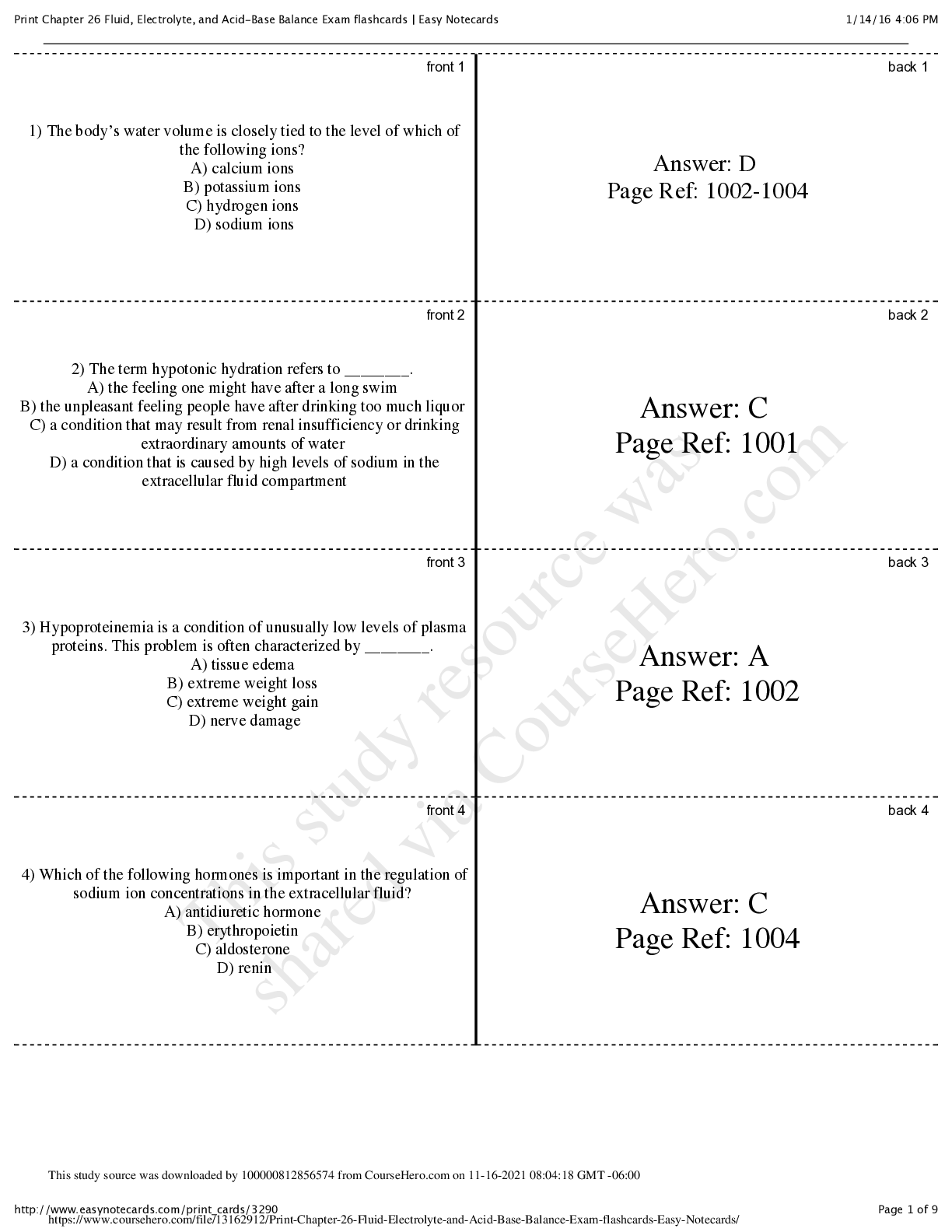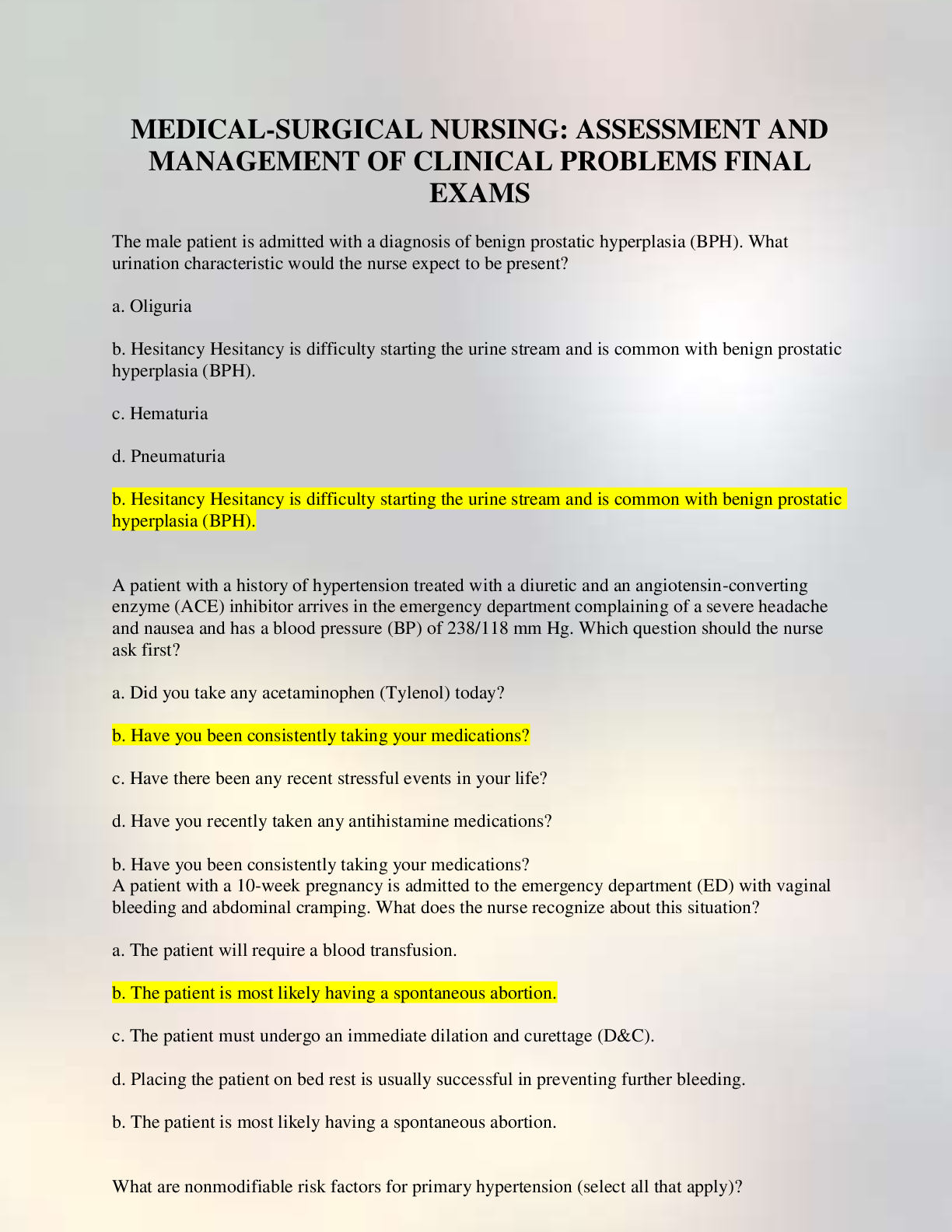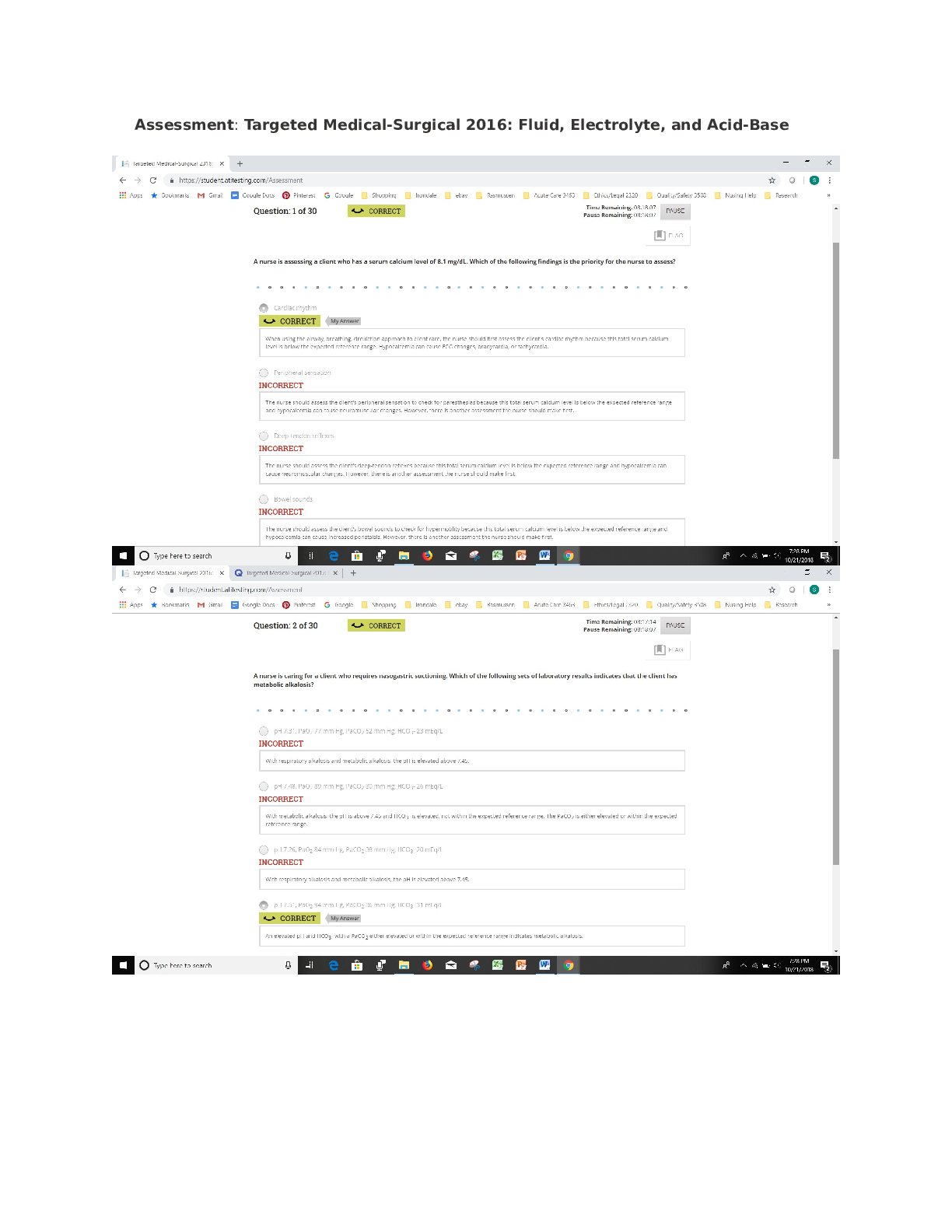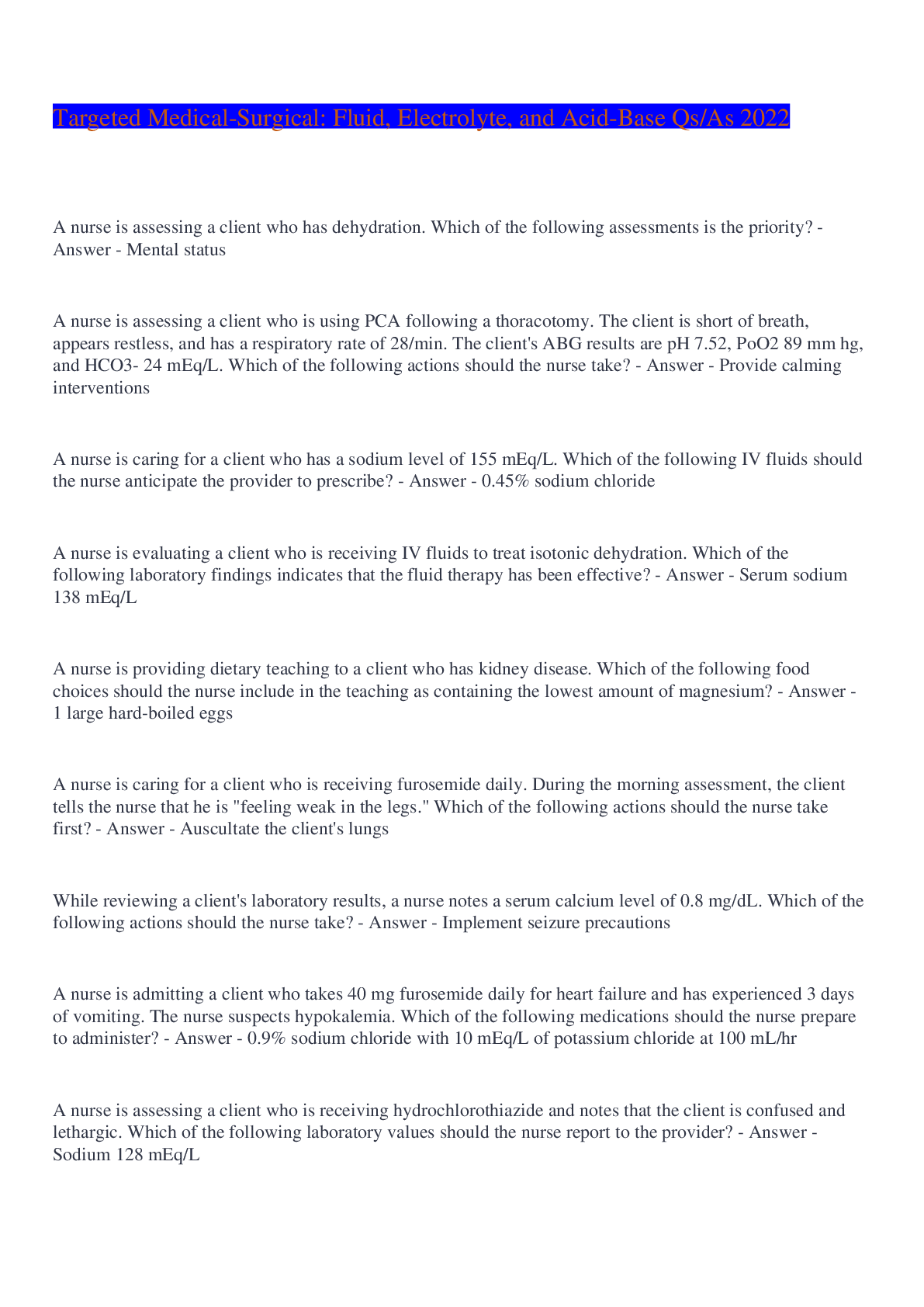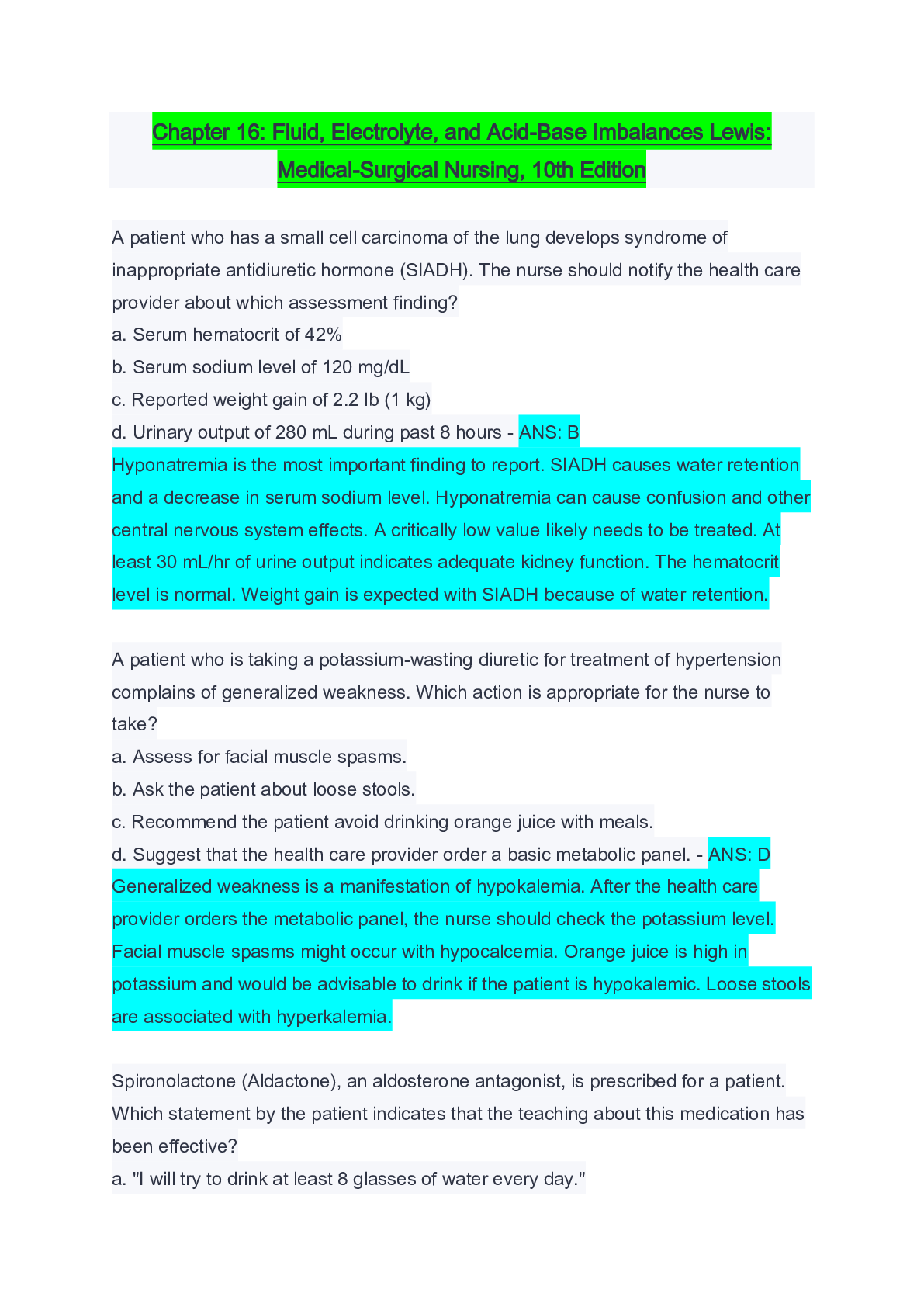Biology > EXAM > Nursing Test Bank Chapter 42: Fluid, Electrolyte, and Acid-Base Balance potter etal:Fundamentals of (All)
Nursing Test Bank Chapter 42: Fluid, Electrolyte, and Acid-Base Balance potter etal:Fundamentals of Nursing ,9th Edition,100% CORRECT
Document Content and Description Below
Nursing Test Bank Chapter 42: Fluid, Electrolyte, and Acid-Base Balance potter etal:Fundamentals of Nursing ,9th Edition MULTIPLE CHOICE 1.A patient has dehydration. While planning care, the nurse ... considers that the majority of the patient’s total water volume exists in with compartment? a. Intracellular b. Extracellular c. Intravascular d. Transcellular ANS: A Intracellular (inside the cells) fluid accounts for approximately two thirds of total body water. Extracellular (out- side the cells) is approximately one third of the total body water. Intravascular fluid (liquid portion of the blood) and transcellular fluid are two major divisions of the extracellular compartment. DIF:Understand (comprehension)REF:935 OBJ escribe the processes involved in regulating extracellular fluid volume, body fluid osmolality, and fluid distribution.TOP lanning MSC: Physiological Adaptation 2. The nurse is teaching about the process of passively moving water from an area of lower particle concentra- tion to an area of higher particle concentration. Which process is the nurse describing? a. Osmosis b. Filtration c. Diffusion d. Active transport ANS: A The process of moving water from an area of low particle concentration to an area of higher particle concentra- tion is known as osmosis. Filtration is mediated by fluid pressure from an area of higher pressure to an area of lower pressure. Diffusion is passive movement of electrolytes or other particles down the concentration gradi- ent (from areas of higher concentration to areas of lower concentration). Active transport requires energy in the form of adenosine triphosphate (ATP) to move electrolytes across cell membranes against the concentra- tion gradient (from areas of lower concentration to areas of higher concentration). DIF:Understand (comprehension)REF:936 OBJ escribe the processes involved in regulating extracellular fluid volume, body fluid osmolality, and fluid distribution.TOP:Teaching/Learning MSC: Physiological Adaptation 3. The nurse observes edema in a patient who has venous congestion from right heart failure. Which type of pressure facilitated the formation of the patient’s edema? a. Osmotic b. Oncotic c. Hydrostatic d. Concentration ANS: C Venous congestion increases capillary hydrostatic pressure. Increased hydrostatic pressure causes edema by causing increased movement of fluid into the interstitial area. Osmotic and oncotic pressures involve the con- centrations of solutes and can contribute to edema in other situations, such as inflammation or malnutrition. Concentration pressure is not a nursing term. DIF:Understand (comprehension)REF:937 OBJ escribe common fluid, electrolyte, and acid-base imbalances. TOP: Assessment MSC: Physiological Adaptation 4. The nurse administers an intravenous (IV) hypertonic solution to a patient. In which direction will the fluid shift? a. From intracellular to extracellular b. From extracellular to intracellular c. From intravascular to intracellular d. From intravascular to interstitial ANS: A Hypertonic solutions will move fluid from the intracellular to the extracellular (intravascular). A hypertonic solu- tion has a concentration greater than normal body fluids, so water will shift out of cells because of the osmotic pull of the extra particles. Movement of water from the extracellular (intravascular) into cells (intracellular) oc- curs when hypotonic fluids are administered. Distribution of fluid between intravascular and interstitial spaces occurs by filtration, the net sum of hydrostatic and osmotic pressures. DIF:Understand (comprehension)REF:936 | 956 OBJ escribe the processes involved in regulating extracellular fluid volume, body fluid osmolality, and fluid distribution.TOP lanning MSC harmacological and Parenteral Therapies 5.A nurse is preparing to start peripheral intravenous (IV) therapy. In which order will the nurse perform the steps starting with the first one? 1. Clean site. 2. Select vein. 3. Apply tourniquet. 4. Release tourniquet. 5. Reapply tourniquet. 6. Advance and secure. 7. Insert vascular access device. a. 1, 3, 2, 7, 5, 4, 6 b. 1, 3, 2, 5, 7, 6, 4 c. 3, 2, 1, 5, 7, 6, 4 d. 3, 2, 4, 1, 5, 7, 6 ANS: D The steps for inserting an intravenous catheter are as follows: Apply tourniquet; select vein; release tourniquet; clean site; reapply tourniquet; insert vascular access device; and advance and secure. DIF:Apply (application)REF:971-974 OBJ iscuss purpose and procedure for initiation and maintenance of intravenous therapy.TOP:Implementation MSC harmacological and Parenteral Therapies 6. The nurse is reviewing laboratory results. Which cation will the nurse observe is the most abundant in the blood? a. Sodium b. Chloride c. Potassium d. Magnesium ANS: A Sodium is the most abundant cation in the blood. Potassium is the predominant intracellular cation. Chloride is an anion (negatively charged) rather than a cation (positively charged). Magnesium is found predominantly in- side cells and in bone. DIF:Apply (application)REF:935-936 OBJ escribe the processes involved in regulating plasma concentrations of potassium, calcium, magnesium, and phosphate ions.TOP:Assessment MSC: Physiological Adaptation 7. The nurse receives the patient’s most recent blood work results. Which laboratory value is of greatest concern? a. Sodium of 145 mEq/L b. Calcium of 15.5 mg/dL c. Potassium of 3.5 mEq/L d. Chloride of 100 mEq/L ANS: B Normal calcium range is 8.4 to 10.5 mg/dL; therefore, a value of 15.5 mg/dL is abnormally high and of concern. The rest of the laboratory values are within their normal ranges: sodium 136 to 145 mEq/L; potassium 3.5 to 5.0 mEq/L; and chloride 98 to 106 mEq/L. DIF:Apply (application)REF:935 OBJ:Interpret basic fluid, electrolyte, and acid-base laboratory values. TOP: Assessment MSC: Reduction of Risk Potential 8. The nurse observes that the patient’s calcium is elevated. When checking the phosphate level, what does the nurse expect to see? a. Increased b. Decreased c. Equal to calcium d. No change in phosphate ANS: B Phosphate will decrease. Serum calcium and phosphate have an inverse relationship. When one is elevated, the other decreases, except in some patients with end-stage renal disease. DIF:Apply (application)REF:941 OBJ escribe the processes involved in regulating plasma concentrations of potassium, calcium, magnesium, and phosphate ions.TOP:Assessment MSC: Physiological Adaptation 9. Four patients arrive at the emergency department at the same time. Which patient will the nurse see first? a. An infant with temperature of 102.2° F and diarrhea for 3 days b. A teenager with a sprained ankle and excessive edema c. A middle-aged adult with abdominal pain who is moaning and holding her stomach d. An older adult with nausea and vomiting for 3 days with blood pressure 112/60 ANS: A The infant should be seen first. An infant’s proportion of total body water (70% to 80% total body weight) is greater than that of children or adults. Infants and young children have greater water needs and immature kid- neys. They are at greater risk for extracellular volume deficit and hypernatremia because body water loss is proportionately greater per kilogram of weight. A teenager with excessive edema from a sprained ankle can wait. A middle-aged adult moaning in pain can wait as can an older adult with a blood pressure of 112/60. DIF:Analyze (analysis)REF:947 OBJ:Apply the nursing process when caring for patients with fluid, electrolyte, and acid-base imbalances.TOP:Assessment MSC:Management of Care 10. The patient has an intravenous (IV) line and the nurse needs to remove the gown. In which order will the nurse perform the steps, starting with the first one? 1. Remove the sleeve of the gown from the arm without the IV. 2. Remove the sleeve of the gown from the arm with the IV. 3. Remove the IV solution container from its stand. 4. Pass the IV bag and tubing through the sleeve. ANS: A Change regular gowns by following these steps for maximum speed and arm mobility: (1) To remove a gown, remove the sleeve of the gown from the arm without the IV line, maintaining the patient’s privacy. (2) Remove the sleeve of the gown from the arm with the IV line. (3) Remove the IV solution container from its stand, and pass it and the tubing through the sleeve. (If this involves removing the tubing from an EID, use the roller clamp to slow the infusion to prevent the accidental infusion of a large volume of solution or medication.) DIF:Understand (comprehension)REF:959-960 OBJ iscuss purpose and procedure for initiation and maintenance of intravenous therapy.TOP:Implementation MSC: Safety and Infection Control 11.A 2-year-old child is brought into the emergency department after ingesting a medication that causes respi- ratory depression. For which acid-base imbalance will the nurse most closely monitor this child? a. Respiratory alkalosis b. Respiratory acidosis c. Metabolic acidosis d. Metabolic alkalosis ANS: B Respiratory depression leads to hypoventilation. Hypoventilation results in retention of CO2 and respiratory aci- dosis. Respiratory alkalosis would result from hyperventilation, causing a decrease in CO2 levels. Metabolic acid-base imbalance would be a result of kidney dysfunction, vomiting, diarrhea, or other conditions that affect metabolic acids. DIF:Analyze (analysis)REF:944- 945 OBJ: Identify risk factors for fluid, electrolyte, and acid-base imbalances. TOP: Assessment MSC: Physiological Adaptation 12.A patient is admitted for a bowel obstruction and has had a nasogastric tube set to low intermittent suction for the past 3 days. Which arterial blood gas values will the nurse expect to observe? a. Respiratory alkalosis b. Metabolic alkalosis c. Metabolic acidosis d. Respiratory acidosis ANS: B The patient is losing acid from the nasogastric tube so the patient will have metabolic alkalosis. Lung problems will produce respiratory alkalosis or acidosis. Metabolic acidosis will occur when too much acid is in the body like kidney failure. DIF:Apply (application)REF:948-949 OBJ escribe common fluid, electrolyte, and acid-base imbalances. TOP: Assessment MSC: Reduction of Risk Potential 13.Which blood gas result will the nurse expect to observe in a patient with respiratory alkalosis? a. pH 7.60, PaCO2 40 mm Hg, HCO3– 30 mEq/L b. pH 7.53, PaCO2 30 mm Hg, HCO3– 24 mEq/L c. pH 7.35, PaCO2 35 mm Hg, HCO3– 26 mEq/L d. pH 7.25, PaCO2 48 mm Hg, HCO3– 23 mEq/L ANS: B Respiratory alkalosis should show an alkalotic pH and decreased CO2 (respiratory) values, with a normal HCO3–. In this case, pH 7.53 is alkaline (normal = 7.35 to 7.45), PaCO2 is 30 (normal 35 to 45 mm Hg), and HCO3– is 24 (normal = 22 to 26 mEq/L). A result of pH 7.60, PaCO2 40 mm Hg, HCO3– 30 mEq/L is metabolic alkalosis. pH 7.35, PaCO2 35 mm Hg, HCO3– 26 mEq/L is within normal limits. pH 7.25, PaCO2 48 mm Hg, HCO – 23 mEq/L is respiratory acidosis. DIF:Analyze (analysis)REF:944-945 OBJ:Interpret basic fluid, electrolyte, and acid-base laboratory values. TOP: Assessment MSC: Reduction of Risk Potential 14.A nurse is caring for a patient whose ECG presents with changes characteristic of hypokalemia. Which as- sessment finding will the nurse expect? a. Dry mucous membranes b. Abdominal distention c. Distended neck veins d. Flushed skin ANS: B Signs and symptoms of hypokalemia are muscle weakness, abdominal distention, decreased bowel sounds, and cardiac dysrhythmias. Distended neck veins occur in fluid overload. Thready peripheral pulses indicate hy- povolemia. Dry mucous membranes and flushed skin are indicative of dehydration and hypernatremia. DIF:Apply (application)REF:942 OBJ: Choose appropriate clinical assessments for specific fluid, electrolyte, and acid-base imbalances. TOP: As- sessment MSC: Physiological Adaptation 15.In which patient will the nurse expect to see a positive Chvostek sign? a. A 7-year-old child admitted for severe burns b. A 24-year-old adult admitted for chronic alcohol abuse c. A 50-year-old patient admitted for an acute exacerbation of hyperparathyroidism d. A 75-year-old patient admitted for a broken hip related to osteoporosis ANS: B A positive Chvostek sign is representative of hypocalcemia or hypomagnesemia. Hypomagnesemia is common with alcohol abuse. Hypocalcemia can be brought on by alcohol abuse and pancreatitis (which also can be af- fected by alcohol consumption). Burn patients frequently experience extracellular fluid volume deficit. Hyper- parathyroidism causes hypercalcemia. Immobility is associated with hypercalcemia. DIF:Apply (application)REF:942 OBJ: Choose appropriate clinical assessments for specific fluid, electrolyte, and acid-base imbalances. TOP: As- sessment MSC: Reduction of Risk Potential 16.A patient is experiencing respiratory acidosis. Which organ system is responsible for compensation in this patient? a. Renal b. Endocrine c. Respiratory d. Gastrointestinal ANS: A The kidneys (renal) are responsible for respiratory acidosis compensation. A problem with the respiratory sys- tem causes respiratory acidosis, so another organ system (renal) needs to compensate. Problems with the gas- trointestinal and endocrine systems can cause acid-base imbalances, but these systems cannot compensate for an existing imbalance. DIF:Understand (comprehension)REF:943-944 OBJ escribe the processes involved in regulating acid-base balance. TOP: Assessment MSC: Physiological Adaptation 17.A nurse is caring for a patient with peripheral intravenous (IV) therapy. Which task will the nurse assign to the nursing assistive personnel? a. Recording intake and output b. Regulating intravenous flow rate c. Starting peripheral intravenous therapy d. Changing a peripheral intravenous dressing ANS: A A nursing assistive personnel (NAP) can record intake and output. An RN cannot delegate regulating flow rate, starting an IV, or changing an IV dressing to an NAP. DIF:Understand (comprehension)REF:951 OBJ:Apply the nursing process when caring for patients with fluid, electrolyte, and acid-base imbalances.TOP lanning MSC:Management of Care 18. The nurse is caring for a diabetic patient in renal failure who is in metabolic acidosis. Which laboratory find- ings are consistent with metabolic acidosis? a. pH 7.3, PaCO2 36 mm Hg, HCO3– 19 mEq/L b. pH 7.5, PaCO2 35 mm Hg, HCO3– 35 mEq/L c. pH 7.32, PaCO2 47 mm Hg, HCO3– 23 mEq/L d. pH 7.35, PaCO2 40 mm Hg, HCO3– 25 mEq/L ANS: A The laboratory values that reflect metabolic acidosis are pH 7.3, PaCO2 36 mm Hg, HCO – 19 mEq/L. A laborato- ry finding of pH 7.5, PaCO2 35 mm Hg, HCO3– 35 mEq/L is metabolic alkalosis. pH 7.32, PaCO2 47 mm Hg, HCO – 23 mEq/L is respiratory acidosis. pH 7.35, PaCO 40 mm Hg, HCO – 25 mEq/L values are within normal range. DIF:Analyze (analysis)REF:944-945 OBJ:Interpret basic fluid, electrolyte, and acid-base laboratory values. TOP: Assessment MSC: Reduction of Risk Potential 19. The nurse is assessing a patient and finds crackles in the lung bases and neck vein distention. Which action will the nurse take first? a. Offer calcium-rich foods. b. Administer diuretic. c. Raise head of bed. d. Increase fluids. ANS: C The patient is in fluid overload. Raising the head of the bed to ease breathing is the first action. Offering calci- um-rich foods is for hypocalcemia, not fluid overload. Administering a diuretic is the second action. Increasing fluids is contraindicated and would make the situation worse. DIF:Apply (application)REF:940 | 950 | 960 OBJ:Apply the nursing process when caring for patients with fluid, electrolyte, and acid-base imbalances.TOP:Implementation MSC:Management of Care 20.A chemotherapy patient has gained 5 pounds in 2 days. Which assessment question by the nurse is most appropriate? a. “Are you following any weight loss program?” b. “How many calories a day do you consume?” c. “Do you have dry mouth or feel thirsty?” d. “How many times a day do you urinate?” ANS: D A rapid gain in weight usually indicates extracellular volume (ECV) excess if the person began with normal ECV. Asking the patient about urination habits will help determine whether the body is trying to excrete the excess fluid or if renal dysfunction is contributing to ECV excess. This is too rapid a weight gain to be dietary; it is fluid retention. Asking about following a weight loss program will not help determine the cause of the problem. Caloric intake does not account for rapid weight changes. Dry mouth and thirst accompany ECV deficit, which would be associated with rapid weight loss. DIF:Apply (application)REF:940 | 948-949 OBJ: Choose appropriate clinical assessments for specific fluid, electrolyte, and acid-base imbalances. TOP: As- sessment MSC: Reduction of Risk Potential 21. The health care provider has ordered a hypotonic intravenous (IV) solution to be administered. Which IV bag will the nurse prepare? a. 0.45% sodium chloride (1/2 NS) b. 0.9% sodium chloride (NS) c. Lactated Ringer’s (LR) d. Dextrose 5% in Lactated Ringer’s (D5LR) ANS: A 0.45% sodium chloride is a hypotonic solution. NS and LR are isotonic. D5LR is hypertonic. DIF:Apply (application)REF:956 OBJ escribe the processes involved in regulating extracellular fluid volume, body fluid osmolality, and fluid distribution.TOP:Implementation MSC harmacological and Parenteral Therapies 22. The health care provider asks the nurse to monitor the fluid volume status of a heart failure patient and a patient at risk for clinical dehydration. Which is the most effective nursing intervention for monitoring both of these patients? a. Assess the patients for edema in extremities. b. Ask the patients to record their intake and output. c. Weigh the patients every morning before breakfast. d. Measure the patients’ blood pressures every 4 hours. ANS: C An effective measure of fluid retention or loss is daily weights; each kilogram (2.2 pounds) change is equivalent to 1 liter of fluid gained or lost. This measurement should be performed at the same time every day using the same scale and the same amount of clothing. Although intake and output records are important assessment measures, some patients are not able to keep their own records themselves. Blood pressure can decrease with extracellular volume (ECV) deficit but will not necessarily increase with recent ECV excess (heart failure patient). Edema occurs with ECV excess but not with clinical dehydration. DIF:Apply (application)REF:949 | 968 OBJ:Apply the nursing process when caring for patients with fluid, electrolyte, and acid-base imbalances.TOP:Implementation MSC: Basic Care and Comfort 23.A nurse is caring for a cancer patient who presents with anorexia, blood pressure 100/60, and elevated white blood cell count. Which primary purpose for starting total parenteral nutrition (TPN) will the nurse add to the care plan? a. Stimulate the patient’s appetite to eat. b. Deliver antibiotics to fight off infection. c. Replace fluid, electrolytes, and nutrients. d. Provide medication to raise blood pressure. ANS: C Total parenteral nutrition is an intravenous solution composed of nutrients and electrolytes to replace the ones the patient is not eating or losing. TPN does not stimulate the appetite. TPN does not contain blood pressure medication or antibiotics. DIF:Apply (application)REF:955 OBJ iscuss the purpose and procedure for initiation and maintenance of intravenous therapy.TOP lan- ningMSC:Management of Care 24.A patient presents to the emergency department with reports of vomiting and diarrhea for the past 48 hours. The health care provider orders isotonic intravenous (IV) therapy. Which IV will the nurse prepare? a. 0.225% sodium chloride (1/4 NS) b. 0.45% sodium chloride (1/2 NS) c. 0.9% sodium chloride (NS) d. 3% sodium chloride (3% NaCl) ANS: C Patients with prolonged vomiting and diarrhea become hypovolemic. A solution to replace extracellular volume is 0.9% sodium chloride, which is an isotonic solution. 0.225% and 0.45% sodium chloride are hypotonic. 3% sodium chloride is hypertonic. DIF:Apply (application)REF:956 OBJ iscuss the purpose and procedure for initiation and maintenance of intravenous therapy.TOP:Implementation MSC harmacological and Parenteral Therapies 25.A nurse is administering a diuretic to a patient and teaching the patient about foods to increase. Which food choices by the patient will best indicate successful teaching? a. Milk and cheese b. Potatoes and fresh fruit c. Canned soups and vegetables d. Whole grains and dark green leafy vegetables ANS: B Potatoes and fruits are high in potassium. Milk and cheese are high in calcium. Canned soups and vegetables are high in sodium. Whole grains and dark green leafy vegetables are high in magnesium. DIF:Apply (application)REF:941 OBJ: Identify risk factors for fluid, electrolyte, and acid-base imbalances. TOP: Teaching/Learning MSC: Reduction of Risk Potential 26. The nurse is evaluating the effectiveness of the intravenous fluid therapy in a patient with hypernatremia. Which finding indicates goal achievement? a. Urine output increases to 150 mL/hr. b. Systolic and diastolic blood pressure decreases. c. Serum sodium concentration returns to normal. d. Large amounts of emesis and diarrhea decrease. ANS: C Hypernatremia is diagnosed by elevated serum sodium concentration. Blood pressure is not an accurate indi- cator of hypernatremia. Emesis and diarrhea will not stop because of intravenous therapy. Urine output is in- fluenced by many factors, including extracellular fluid volume. A large dilute urine output can cause further hypernatremia. DIF:Apply (application)REF:940 | 966 OBJ:Apply the nursing process when caring for patients with fluid, electrolyte, and acid-base imbalances.TOP:Evaluation MSC: Physiological Adaptation 27. The nurse is calculating intake and output on a patient. The patient drinks 150 mL of orange juice at break- fast, voids 125 mL after breakfast, vomits 250 mL of greenish fluid, sucks on 60 mL of ice chips, and for lunch consumes 75 mL of chicken broth. Which totals for intake and output will the nurse document in the patient’s medical record? a. Intake 255; output 375 b. Intake 285; output 375 c. Intake 505; output 125 d. Intake 535; output 125 ANS: A Intake = 150 mL of orange juice, 60 mL of ice chips (but only counts as 30 since ice chips are half of the amount), and 75 mL of chicken broth; 150 + 30 + 75 = 255. Output = 125 mL of urine (void) and 250 mL of vomi- tus; 125 + 250 = 375. DIF:Apply (application)REF:949 | 951 | 955 OBJ escribe how to measure and record fluid intake and output. TOP: Implementation MSC: Basic Care and Comfort 28.A nurse is assessing a patient. Which assessment finding should cause a nurse to further assess for extra- cellular fluid volume deficit? a. Moist mucous membranes b. Postural hypotension c. Supple skin turgor d. Pitting edema ANS: B Physical examination findings of deficit include postural hypotension, tachycardia, thready pulse, dry mucous membranes, and poor skin turgor. Pitting edema indicates that the patient may be retaining excess extracellu- lar fluid. DIF:Apply (application)REF:940 OBJ: Choose appropriate clinical assessments for specific fluid, electrolyte, and acid-base imbalances. TOP: As- sessment MSC: Physiological Adaptation 29.A patient is to receive 1000 mL of 0.9% sodium chloride intravenously at a rate of 125 mL/hr. The nurse is using microdrip gravity drip tubing. Which rate will the nurse calculate for the minute flow rate (drops/min)? a. 12 drops/min b. 24 drops/min c. 125 drops/min d. 150 drops/min ANS: C Microdrip tubing delivers 60 drops/mL. Calculation for a rate of 125 mL/hr using microdrip tubing: (125 mL/1 hr)(60 drops/1 mL)(1 hr/60 min) = 125 drop/min. DIF:Apply (application)REF:978 OBJ:Calculate an intravenous flow rate.TOP:Implementation MSC harmacological and Parenteral Therapies 30.A nurse begins infusing a 250-mL bag of IV fluid at 1845 on Monday and programs the pump to infuse at 50 mL/hr. At what time should the infusion be completed? a. 2300 Monday b. 2345 Monday c. 0015 Tuesday d. 0045 Tuesday ANS: B 250 mL ÷ 50 mL/hr = 5 hr 1845 + 5 hr = 2345, which would be 2345 on Monday. DIF:Apply (application)REF:978 OBJ:Calculate an intravenous flow rate.TOP:Implementation MSC harmacological and Parenteral Therapies 31.A nurse is caring for a diabetic patient with a bowel obstruction and has orders to ensure that the volume of intake matches the output. In the past 4 hours, the patient received dextrose 5% with 0.9% sodium chloride through a 22-gauge catheter infusing at 150 mL/hr and has eaten 200 mL of ice chips. The patient also has an NG suction tube set to low continuous suction that had 300-mL output. The patient has voided 400 mL of urine. After reporting these values to the health care provider, which order does the nurse anticipate? a. Add a potassium supplement to replace loss from output. b. Decrease the rate of intravenous fluids to 100 mL/hr. c. Administer a diuretic to prevent fluid volume excess. d. Discontinue the nasogastric suctioning. ANS: A The total fluid intake and output equals 700 mL, which meets the provider goals. Patients with nasogastric suc- tioning are at risk for potassium deficit, so the nurse would anticipate a potassium supplement to correct this condition. Remember to record half the volume of ice chips when calculating intake. The other measures would be unnecessary because the net fluid volume is equal. DIF:Analyze (analysis)REF:949 | 951 | 955 OBJ escribe how to measure and record fluid intake and output. TOP lanningMSC harmacological and Parenteral Therapies 32.A nurse is caring for a patient who is receiving peripheral intravenous (IV) therapy. When the nurse is flush- ing the patient’s peripheral IV, the patient reports pain. Upon assessment, the nurse notices a red streak that is warm to the touch. What is the nurse’s initial action? a. Record a phlebitis grade of 4. b. Assign an infiltration grade. c. Apply moist compress. d. Discontinue the IV. ANS: D The IV site has phlebitis. The nurse should discontinue the IV. The phlebitis score is 3. The site has phlebitis, not infiltration. A moist compress may be needed after the IV is discontinued. DIF:Apply (application)REF:960 | 982 OBJ: Describe potential complications of intravenous therapy and what to do if they occur. TOP:ImplementationMSC:Management of Care 33.A nurse is assisting the health care provider in inserting a central line. Which action indicates the nurse is following the recommended bundle protocol to reduce central line-associated bloodstream infections (CLABSI)? a. Preps skin with povidone-iodine solution. b. Suggests the femoral vein for insertion site. c. Applies double gloving without hand hygiene. d. Uses chlorhexidine skin antisepsis prior to insertion. ANS: D A recommended bundle at insertion of a central line is hand hygiene prior to catheter insertion; use of maxi- mum sterile barrier precautions upon insertion; chlorhexidine skin antisepsis prior to insertion and during dressing changes; avoidance of the femoral vein for central venous access for adults; and daily evaluation of line necessity, with prompt removal of non-essential lines. Povidone-iodine is not recommended. DIF:Apply (application)REF:957 OBJ iscuss purpose and procedure for initiation and maintenance of intravenous therapy.TOP:Implementation MSC: Safety and Infection Control 34.The nurse is caring for a group of patients. Which patient will the nurse see first? a. A patient with D5W hanging with the blood b. A patient with type A blood receiving type O blood c. A patient with intravenous potassium chloride that is diluted d. A patient with a right mastectomy and an intravenous site in the left arm ANS: A The nurse will see the patient with D5W and blood to prevent a medication error. When preparing to adminis- ter blood, prime the tubing with 0.9% sodium chloride (normal saline) to prevent hemolysis or breakdown of RBCs. All the rest are normal. A patient with type A blood can receive type O. Type O is considered the universal donor. A patient with a mastectomy should have the IV in the other arm. Potassium chloride should be diluted, and it is never given IV push. DIF:Analyze (analysis)REF:962 OBJ:Apply the nursing process when caring for patients with fluid, electrolyte, and acid-base imbalances.TOP:Assessment MSC:Management of Care 35.A nurse is administering a blood transfusion. Which assessment finding will the nurse report immediately? a. Blood pressure 110/60 b. Temperature 101.3° F c. Poor skin turgor and pallor d. Heart rate of 100 beats/min ANS: B A fever should be reported immediately and the blood transfusion stopped. All other assessment findings are expected. Blood is given to elevate blood pressure, improve pallor, and decrease tachycardia. DIF:Apply (application)REF:962 | 964 OBJ iscuss the procedure for initiating a blood transfusion and interventions to manage a transfusion reaction.TOP:Assessment MSC:Management of Care 36.A nurse has just received a bag of packed red blood cells (RBCs) for a patient. What is the longest time the nurse can let the blood infuse? a. 30 minutes b. 2 hours c. 4 hours d. 6 hours ANS: C Ideally a unit of whole blood or packed RBCs is transfused in 2 hours. This time can be lengthened to 4 hours if the patient is at risk for extracellular volume excess. Beyond 4 hours there is a risk for bacterial contamination of the blood. DIF:Understand (comprehension)REF:962-963 OBJ iscuss the procedure for initiating a blood transfusion and interventions to manage a transfusion reaction.TOP:Implementation MSC harmacological and Parenteral Therapies 37.A patient has an acute intravascular hemolytic reaction to a blood transfusion. After discontinuing the blood transfusion, which is the nurse’s next action? a. Discontinue the IV catheter. b. Return the blood to the blood bank. c. Run normal saline through the existing tubing. d. Start normal saline at TKO rate using new tubing. ANS: D The nurse should first attach new tubing and begin running in normal saline at a rate to keep the vein open, in case any medications need to be delivered through an IV site. The existing tubing should not be used because that would infuse the blood in the tubing into the patient. It is necessary to preserve the IV catheter in place for IV access to treat the patient. After the patient has been assessed and stabilized, the blood can be returned to the blood bank. DIF:Apply (application)REF:963-964 OBJ iscuss the procedure for initiating a blood transfusion and interventions to manage a transfusion reaction.TOP:Implementation MSC:Management of Care 38.A nurse is assessing a patient who is receiving a blood transfusion and finds that the patient is anxiously fid- geting in bed. The patient is afebrile and dyspneic. The nurse auscultates crackles in both lung bases and sees jugular vein distention. On which transfusion complication will the nurse focus interventions? a. Fluid volume overload b. Hemolytic reaction c. Anaphylactic shock d. Septicemia ANS: A The signs and symptoms are concurrent with fluid volume overload. Anaphylactic shock would have presented with urticaria, dyspnea, and hypotension. Septicemia would include a fever. A hemolytic reaction would consist of flank pain, chills, and fever. DIF:Apply (application)REF:963-964 OBJ iscuss the procedure for initiating a blood transfusion and interventions to manage a transfusion reac- tion.TOP lanning MSC:Management of Care 39.A nurse is preparing to start a blood transfusion. Which type of tubing will the nurse obtain? a. Two-way valves to allow the patient’s blood to mix and warm the blood transfusing b. An injection port to mix additional electrolytes into the blood c. A filter to ensure that clots do not enter the patient d. An air vent to let bubbles into the blood ANS: C When administering a transfusion you need an appropriate-size IV catheter and blood administration tubing that has a special in-line filter. The patient’s blood should not be mixed with the infusion blood. Air bubbles should not be allowed to enter the blood. The only substance compatible with blood is normal saline; no addi- tives should be mixed with the infusing blood. DIF:Apply (application)REF:962 OBJ iscuss the procedure for initiating a blood transfusion and interventions to manage a transfusion reac- tion.TOP lanning MSC harmacological and Parenteral Therapies 40. The nurse is caring for a patient with hyperkalemia. Which body system assessment is the priority? a. Gastrointestinal b. Neurological c. Respiratory d. Cardiac ANS: D Cardiac is the priority. Hyperkalemia places the patient at risk for potentially serious dysrhythmias and cardiac arrest. Potassium balance is necessary for cardiac function. Respiratory is the priority with hypokalemia. Moni- toring of gastrointestinal and neurological systems would be indicated for other electrolyte imbalances. DIF:Apply (application)REF:941-942 | 956 OBJ:Apply the nursing process when caring for patients with fluid, electrolyte, and acid-base imbalances.TOP:Assessment MSC:Management of Care 41. Which assessment finding will the nurse expect for a patient with the following laboratory values: sodium 145 mEq/L, potassium 4.5 mEq/L, calcium 4.5 mg/dL? a. Weak quadriceps muscles b. Decreased deep tendon reflexes c. Light-headedness when standing up d. Tingling of extremities with possible tetany ANS: D This patient has hypocalcemia because the normal calcium range is 8.4 to 10.5 mg/dL. Hypocalcemia causes muscle tetany, positive Chvostek’s sign, and tingling of the extremities. Sodium and potassium values are with- in their normal ranges: sodium 135 to 145 mEq/L; potassium 3.5 to 5.0 mEq/L. Light-headedness when stand- ing up is a manifestation of ECV deficit or sometimes hypokalemia. Weak quadriceps muscles are associated with potassium imbalances. Decreased deep tendon reflexes are related to hypercalcemia or hypermagnesemia. DIF:Analyze (analysis)REF:935 | 942 | 950 OBJ: Choose appropriate clinical assessments for specific fluid, electrolyte, and acid-base imbalances. TOP: As- sessment MSC: Reduction of Risk Potential 42. While the nurse is taking a patient history, the nurse discovers the patient has a type of diabetes that results from a head injury and does not require insulin. Which dietary change should the nurse share with the patient? a. Reduce the quantity of carbohydrates ingested to lower blood sugar. b. Include a serving of dairy in each meal to elevate calcium levels. c. Drink plenty of fluids throughout the day to stay hydrated. d. Avoid food high in acid to avoid metabolic acidosis. ANS: C The patient has diabetes insipidus, which places the patient at risk for dehydration and hypernatremia. Dehy- dration should be prevented by drinking plenty of fluids to replace the extra water excreted in the urine. Foods high in acid are not what causes metabolic acidosis. A reduction in carbohydrates to lower blood sugar will not help a patient with diabetes insipidus but it may help a patient with diabetes mellitus. Calcium-rich dairy prod- ucts would be recommended for a hypocalcemic patient. DIF:Apply (application)REF:949 OBJ:Apply the nursing process when caring for patients with fluid, electrolyte, and acid-base imbalances.TOP:Implementation MSC: Physiological Adaptation MULTIPLE RESPONSE 1.A nurse is selecting a site to insert an intravenous (IV) catheter on an adult. Which actions will the nurse take? (Select all that apply.) a. Check for contraindications to the extremity. b. Start proximally and move distally on the arm. c. Choose a vein with minimal curvature. d. Choose the patient’s dominant arm. e. Select a vein that is rigid. f. Avoid areas of flexion. ANS: A, C, F The vein should be relatively straight to avoid catheter occlusion. Contraindications to starting an IV catheter are conditions such as mastectomy, AV fistula, and central line in the extremity and should be checked before initiation of IV. Avoid areas of flexion if possible. The nurse should start distally and move proximally, choosing the nondominant arm if possible. The nurse should feel for the best location; a good vein should feel spongy, a rigid vein should be avoided because it might have had previous trauma or damage. DIF:Apply (application)REF:957 | 972 OBJ iscuss the purpose and procedure for initiation and maintenance of intravenous therapy.TOP:Implementation MSC harmacological and Parenteral Therapies 2.Which assessments will alert the nurse that a patient’s IV has infiltrated? (Select all that apply.) a. Edema of the extremity near the insertion site b. Reddish streak proximal to the insertion site c. Skin discolored or pale in appearance d. Pain and warmth at the insertion site e. Palpable venous cord f. Skin cool to the touch ANS: A, C, F Infiltration results in skin that is edematous near the IV insertion site. Skin is cool to the touch and may be pale or discolored. Pain, warmth, erythema, a reddish streak, and a palpable venous cord are all symptoms of phlebitis. DIF:Understand (comprehension)REF:960-961 OBJ: Describe potential complications of intravenous therapy and what to do if they occur. TOP: Assessment MSC: Reduction of Risk Potential 3.A nurse is discontinuing a patient’s peripheral IV access. Which actions should the nurse take? (Select all that apply.) a. Wear sterile gloves and a mask. b. Stop the infusion before removing the IV catheter. c. Use scissors to remove the IV site dressing and tape. d. Apply firm pressure with sterile gauze during removal. e. Keep the catheter parallel to the skin while removing it. f. Apply pressure to the site for 2 to 3 minutes after removal. ANS: B, E, F The nurse should stop the infusion before removing the IV catheter, so the fluid does not drip on the patient’s skin; keep the catheter parallel to the skin while removing it to reduce trauma to the vein; and apply pressure to the site for 2 to 3 minutes after removal to decrease bleeding from the site. Scissors should not be used be- cause they may accidentally cut the catheter or tubing or may injure the patient. During removal of the IV catheter, light pressure, not firm pressure, is indicated to prevent trauma. Clean gloves are used for discontinu- ing a peripheral IV access because gloved hands will handle the external dressing, tubing, and tape, which are not sterile. DIF:Understand (comprehension)REF:985-986 OBJ: Explain how to change intravenous solutions and tubing and discontinue an infusion. TOP:AssessmentMSC harmacological and Parenteral Therapies COMPLETION 1.A patient has 250 mL of a jejunostomy feeding with 30 mL of water before and after feeding and 200 mL of urine. Thirty minutes later the patient has 100 mL of diarrhea. At 1300 the patient receives 150 mL of blood and voids another 200 mL. Calculate the patient’s intake. Record your answer as a whole number. mL ANS: 460 The patient’s fluid intake is 250 mL of feeding, 60 mL of water (30 mL before and after), and 150 blood: . Fluid intake includes all liquids that a person eats (e.g., gelatin, ice cream, soup), drinks (e.g., water, coffee, juice), or receives through nasogastric or jejunostomy feeding tubes. IV fluids (continuous infusions and intermittent IV piggybacks) and blood components also are sources of intake. Fluid output includes urine, diarrhea, vomitus, gastric suction, and drainage from postsurgical wounds or other tubes. DIF:Apply (application)REF:949 | 951 | 955 OBJ escribe how to measure and record fluid intake and output. TOP: Implementation MSC: Basic Care and Comfort MATCHING A nurse is monitoring patients for fluid and electrolyte and acid-base imbalances. Match the body’s regulators to the function it provides. a. Increases excretion of sodium and water b. Reduces excretion of sodium and water c. Reduces excretion of water d. Major buffer in the extracellular fluid e. Vasoconstricts and stimulates aldosterone release 1. Antidiuretic hormone 2. Angiotensin II 3. Aldosterone 4. Atrial natriuretic peptide 5. Bicarbonate 1. ANS:CDIF:Understand (comprehension)REF:938-939 | 943 OBJ escribe the processes involved in regulating extracellular fluid volume, body fluid osmolality, and fluid distribution.TOP lanning MSC: Physiological Adaptation 2. ANS:EDIF:Understand (comprehension)REF:938-939 | 943 OBJ escribe the processes involved in regulating extracellular fluid volume, body fluid osmolality, and fluid distribution.TOP lanning MSC: Physiological Adaptation 3. ANS:BDIF:Understand (comprehension)REF:938-939 | 943 OBJ escribe the processes involved in regulating extracellular fluid volume, body fluid osmolality, and fluid distribution.TOP lanning MSC: Physiological Adaptation 4. ANS:ADIF:Understand (comprehension)REF:938-939 | 943 OBJ escribe the processes involved in regulating extracellular fluid volume, body fluid osmolality, and fluid distribution.TOP lanning MSC: Physiological Adaptation 5.ANS DIF:Understand (comprehension)REF:938-939 | 943 OBJ escribe the processes involved in regulating extracellular fluid volume, body fluid osmolality, and fluid distribution.TOP lanning MSC: Physiological Adaptation [Show More]
Last updated: 1 year ago
Preview 1 out of 37 pages
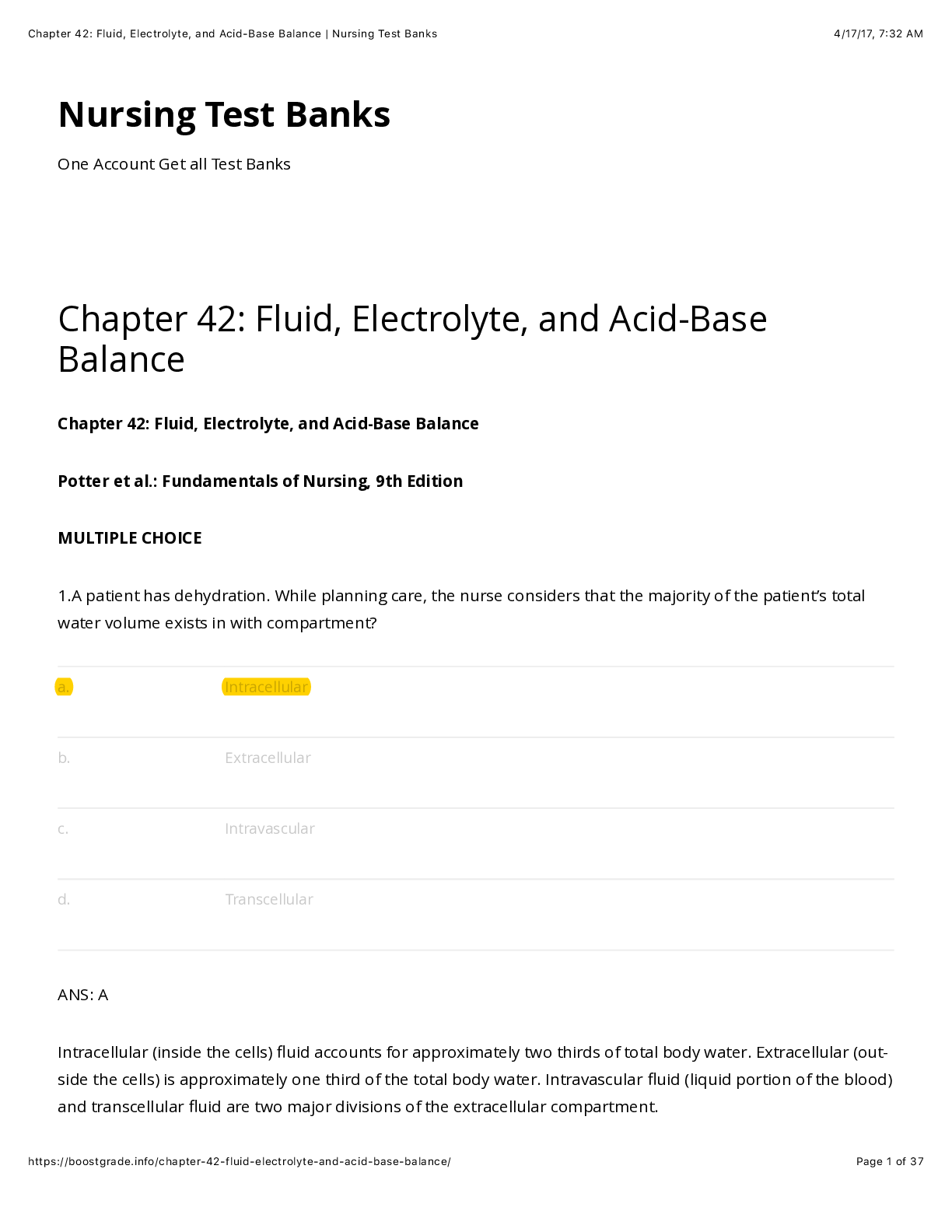
Buy this document to get the full access instantly
Instant Download Access after purchase
Add to cartInstant download
We Accept:

Reviews( 0 )
$17.00
Document information
Connected school, study & course
About the document
Uploaded On
Mar 23, 2021
Number of pages
37
Written in
Additional information
This document has been written for:
Uploaded
Mar 23, 2021
Downloads
0
Views
47













